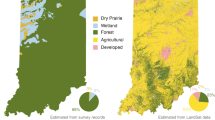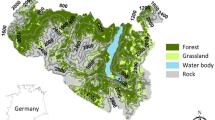
Overview
- Explains how trees can co-exist by analyzing the influences of large-scale disturbances on regeneration
- Highlights the need for long-term ecological studies of climate change impacts on forests
- Explains cascade effects within an ecosystem
Part of the book series: Ecological Research Monographs (ECOLOGICAL)
Buy print copy
Tax calculation will be finalised at checkout
About this book
This open access book presents and analyzes the results of more than 30 years of long-term ecological research in riparian forest ecosystems with the aim of casting light on changes in the dynamics of riparian forests over time. The research, focusing on the Ooyamazawa riparian forest, one of the remaining old-growth forests in Japan, has yielded a number of interesting outcomes. First, it shows that large-scale disturbances afford various trees opportunities for regeneration and are thus the driving force for the coexistence of canopy trees in riparian forests. Second, it identifies changes in reproductive patterns, highlighting that seed production has in fact quantitatively increased over the past two decades. Third, it describes the decline in forest floor vegetation caused by deer grazing and reveals how this decline has affected bird and insect populations. The book illustrates the interconnectedness of phenomena within an ecosystem and the resultant potential for cascade effects and also stresses the need for long-term ecological studies of climate change impacts on forests. It will be of interest to both professionals and academics in the field of forest science.
Similar content being viewed by others
Keywords
Table of contents (12 chapters)
-
Front Matter
-
Introduction
-
Front Matter
-
-
Life History and Regeneration Processes of Riparian Woody Species
-
Front Matter
-
-
Diversity and Coexistence in Riparian Forests
-
Front Matter
-
-
Ecosystem Changes in Riparian Forests
-
Front Matter
-
-
Conclusion
-
Front Matter
-
-
Back Matter
Editors and Affiliations
About the editor
Hitoshi Sakio is a Professor and Director of Sado Island Center for Ecological Sustainability, Niigata University in Niigata, Japan. He received his Ph.D. from Tokyo Metropolitan University, Japan. Hitoshi worked as a forest researcher in local government before moving to Niigata University. He is the leader of riparian forest research in Japan, and his teaching and research focus on forest ecology, especially riparian forest dynamics, tree life history, and alpine forest vegetation. He has published over 50 articles on field research in peer-reviewed journals, edited seven books and written 20 book chapters. He has received various honors for his outstanding contributions to research and education, including The Ecological Society of Japan’s 12th Oshima Award (2019) and The Japanese Forest Society Award (2019).
Bibliographic Information
Book Title: Long-Term Ecosystem Changes in Riparian Forests
Editors: Hitoshi Sakio
Series Title: Ecological Research Monographs
DOI: https://doi.org/10.1007/978-981-15-3009-8
Publisher: Springer Singapore
eBook Packages: Biomedical and Life Sciences, Biomedical and Life Sciences (R0)
Copyright Information: The Editor(s) (if applicable) and The Author(s) 2020
Hardcover ISBN: 978-981-15-3008-1Published: 20 May 2020
Softcover ISBN: 978-981-15-3011-1Published: 18 September 2020
eBook ISBN: 978-981-15-3009-8Published: 19 May 2020
Series ISSN: 2191-0707
Series E-ISSN: 2191-0715
Edition Number: 1
Number of Pages: VIII, 234
Number of Illustrations: 108 b/w illustrations, 65 illustrations in colour
Topics: Ecology, Forestry, Plant Ecology, Ecosystems, Environment, general



